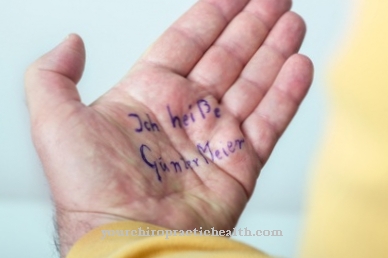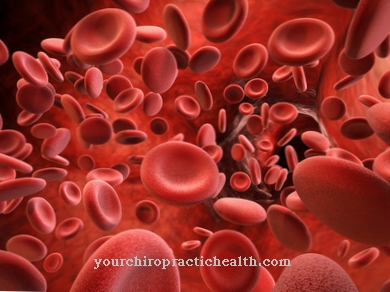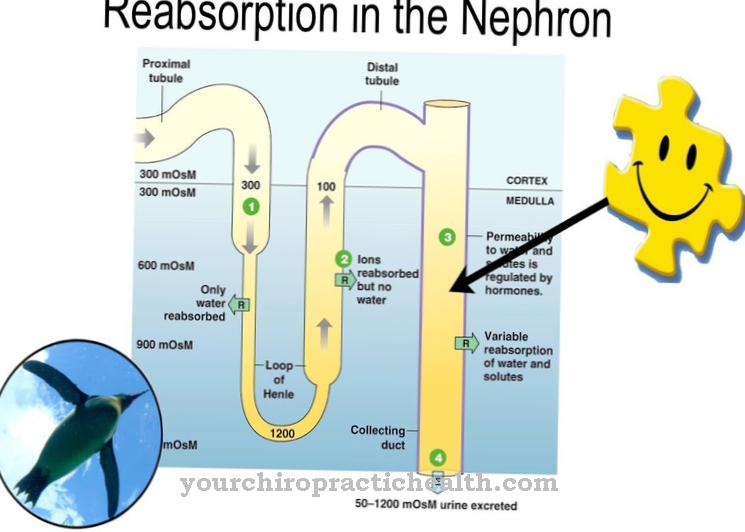Under the Stretch reflex the self-reflex is understood, in which a stretching of the muscle leads to the contraction of the same in order to either maintain or change the muscle length. The stretch reflex is based on a monosynaptic reflex arc and is measured using the muscle spindles that protect the muscle from overstretching. A doctor tests the stretch reflex using the patellar tendon reflex, which is also a self-reflex that is triggered by a light tap on the patellar tendon and thus leads to a contraction of the thigh extensor muscles, which in turn causes the knee joint to stretch. The stretch reflex then occurs shortly after the blow and causes the lower leg to snap forward.
What is the stretch reflex?

The stretch reflex is understood as the self-reflex in which stretching of the muscle leads to contraction of the same.
The brain receives all information about the position, movement and posture of the body through proprioreceptors. These sit in tendons, joints, muscles and ligaments and each respond to stretching, deformation and pressure.
In this way, signals are passed on that lead to decisions to quickly change the position of the body if necessary. The brain then sends appropriate transmissions and commands back to the muscles and the feedback loop closes.
In this way, all positions of the muscles are changed, corrected and adapted. This mainly happens in the muscle spindles. They are located in the skeletal muscles and are made up of muscle fibers. These in turn are surrounded by fine nerve fibers that register the changes in length through stretching. In order to be able to straighten the leg, the quadriceps femoris muscle is used, a skeletal muscle in the thigh made up of four muscle heads.
Function & task
A stretch reflex serves first of all to enable people to walk upright and move around. On the other hand, he is responsible for the correct position of the limbs, which must find their way back to their necessary starting position during target motor movements. The state of stretch of the muscles can be influenced.
This happens through contractions, which play an essential role in actively controlled movement sequences. The proprioceptors in the joints and muscles convey information about the position, posture and movement of the body. In this way, it is possible that even if the muscles change, a stretching stimulus occurs and the muscle spindles ensure that disturbances in the sequence of movements can also be corrected immediately. This can e.g. B. be the case when twisting your foot.
In the skeletal muscles there are Golgi tendon organs that are not parallel to the muscle fibers, as is the case with the muscle spindles, but one behind the other. Mechanosensitive fibers lie in the connective tissue of the joints and also provide information that reacts to changes in direction, speed and angle.
In the case of a stretch reflex, the excitation is conducted via fibers to the spinal cord, where the information is evaluated at the same time. From there, it is transferred to the alpha motor neurons, which causes the muscles that contain muscle spindles to contract. More precisely, this transmission is immediately answered with a reflex, even before the interneurons pass the information on to the brain. At the same time, the fibers of the muscle spindle are connected to the contracted muscle. This happens via an inhibiting interneuron.
As soon as the stretching and muscle tension become stronger, it is minimized again via the tendon organs and their sensory fibers. Tendon organs are connected by alpha motor neurons and interneurons. The reflex running over it is called monosynaptic in the transmission of excitation.
In the case of a monosynaptic stretch reflex, the stretching of the muscle fibers is registered by the muscle spindles and an action potential is triggered in the nerve fibers that is passed on to the spinal cord. This leads to an increased activity of the alpha motor neurons and a contraction of the muscle. The Golgi tendon organs work as a tension meter in this context. In this way, stimuli are always answered quickly. The less the muscle fibers of an alpha motor neuron are innervated, the better the movement is coordinated. This is e.g. B. the case in the finger or eye muscles.
You can find your medication here
➔ Medicines for paresthesia and circulatory disordersIllnesses & ailments
The patellar reflex as a stretch reflex is carried out by the doctor on a sitting patient with a small reflex hammer. The patient loosely slaps one leg over the other, while a light slap occurs below the kneecap on the patellar tendon. The leg then swings upwards as the tendon and core sac region of the muscle fiber are stretched. The dynamic stretching is transmitted monosynaptically to the alpha motor neurons via Ia afferents and the contraction starts immediately after the stretching.
This allows the doctor to check how strong the reflex is and what the condition of the muscles and nerves is. The reflex is triggered several times, the other leg is also tested and finally the reflex reaction is compared. If the reflex is too weak, the doctor uses the so-called Jendrassik handle. The patient bends his arms in front of the upper body and crosses his hands. The doctor prompts you to forcefully pull your hands apart and hold the position while testing the reflex on the leg.
A weakened reflex response can be an indication of neuropathy. This denotes diseases of the peripheral nerves that are not of a traumatic cause. The damage can affect individual nerves or multiple nerves. The disease is then divided into either mono- or polyneuropathy.
An increased reaction of the reflex is possibly a pyramidal orbit sign, by which neurological symptoms are meant that have arisen from damage to the pyramidal path and lead to pathological reflexes. If there is no reflex at all, there is a lumbar disc herniation or a peripheral nerve injury.













.jpg)

.jpg)
.jpg)











.jpg)